Nothing says summer in the South like crepe myrtles. Found in many shapes, sizes, and varieties, their arching branches make them a mainstay for framing many a courtyard. The tree loves heat and humidity, tolerates drought, and grows quickly. Unlike the azalea, camellia, and gardenia, which pine for acid soil, crepe myrtle (Lythraceae) flourishes just about everywhere. No wonder it ranks as the South’s most popular (and coveted) ornamental tree.
Unfortunately, these beautiful trees are also victims of some serious crime. Every year in late winter and spring well-meaning but unaware homeowners chop them down to thick, ugly stumps (a crime known as «crepe murder»). Their motive? They likely bought a crepe myrtle only for its color without checking how big the plant will get. So when it inevitably blocks the upstairs windows just a few years after planting, out comes Angry Homeowner wielding the pruning saw.
Let’s put a stop to this terrible practice now by choosing crepe myrtles by color and size, and we’re here to help. Below you’ll find a guide to crepe myrtle heights with info on their summer bloom color and fall leaf color as well. (As gorgeous as their summer blooms are, just wait until you see a crepe myrtle in full fall mode. Orange, red, and yellow foliage replaces the brilliant blooms for an outstanding autumn show.)
How Tall do Crepe Myrtles Get?
Crepe myrtles—or crape myrtles and crapemyrtles if you prefer—range in size from dwarf selections that grow less than 3 feet tall to several large varieties that reach upwards of 30 feet. Knowing the mature height of a plant before you buy it and planting the proper size for the site will save you much heartache (and backache) in the future. Most crepe myrtles planted today are selections of Lythraceae indica—a species first introduced into the U.S. from China in the early 1800s by famed botanist Andre Michaux in Charleston, South Carolina—or hybrids between L. indica and Lythraceae faurei, an upright tree that reaches heights of 25-50 feet with arching branches.
Mature size is so important that we’ve grouped popular selections into dwarf (2-5 feet tall), semi-dwarf or short (6-10 feet tall) medium (11-20 feet tall), and tall (21-50 feet.) categories. Use dwarf kinds in containers, mixed borders, and masses. Use short types in containers, shrub borders, or near the house. Use medium types as small shade trees, street trees, or for screening. Give tall types lots of room and don’t plant near the house. One «Natchez» is plenty for a 900-square feet lawn.
Dwarf Crepe Myrtles
| Name | Form/Height | Flower Color | Fall Foliage | Mildew Resistance | Comments |
| ‘Chicksaw’ | Dense mound 3-4 feet tall and wide | Lavender-pink | Bronze-red | Very good | Slow grower; great in container |
| ‘Enduring Summer’ | Rounded 4-5 feet tall and wide | White or red | Burgundy-red | Very good | Long blooming early summer through fall. Hardy from zone 6-9. |
| ‘Pocomoke’ | Mounding, 2-3 feet high, 3-4 feet wide | Rosy pink | Bronze-red | High | Great in containers; no pruning needed; heavy bloomer; cold hardy |
| Razzle Dazzle series | Mounding, 3-4 feet high and wide | See comments | Burgundy | Good | Begins blooming a little later than most crepe myrtles, usually in July; selections include ‘Cherry Dazzle’ (our favorite), cherry-red blooms; ‘Diamond Dazzle,’ white blooms; and ‘Sweetheart Dazzle,’ bubble-gum-pink |
| ‘Summerlasting’ | 3 feet tall and wide | Raspberry, White, Bright pink, Plum | Bronze | Good | Long bloom season; does great in containers; zone 7-10 |
| ‘Tightwad Red’ | Tight mound 3-4 feet tall and wide | Deep red | Burgundy | High | Small leaves emerge wine-red in spring, changing to deep green in summer; sterile—no seed pods; cold hardy |
| ‘Victor’ | Compact, 3-5 feet tall and wide | Deep red | Orange-yellow | Good | Cold hardy |
Semi-Dwarf or Short Crepe Myrtles
| Name | Form/Height | Flower Color | Fall Foliage | Mildew Resistance | Comments |
| ‘Acoma’ | Arching, spreading, 6-10 feet tall and wide | White | Reddish purple | High | Handsome, light gray bark; repeat bloomer; cold hardy; our favorite white |
| ‘Delta Jazz’ (part of the Southern Living Plant Collection) | Upright, 6-10 feet tall, 4-5 feet wide | Pink | Burgundy | Good | Dark burgundy leaves are main attraction; not a heavy bloomer |
| Early Bird series (part of the Southern Living Plant Collection) |
Upright, 5-8 feet high, 3-4 feet wide | White, lavender or purple | Burgundy-red | Good | Blooms earlier than most crepe myrtles, as early as Mother’s Day; reblooms over summer, offering over 100 days of blooms; great in containers |
| ‘Hopi’ | Spreading, bushy, 7-10 feet tall and wide | Medium pink | Orange-red | High | Handsome, gray-brown bark; repeat bloomer; cold hardy |
| Magic series | Rounded, bushy, 7-10 feet tall and wide | See comments | Light yellow | Good | Selections include ‘Coral Magic’ (coral-pink blooms), ‘Plum Magic’ (fuchsia-pink), and ‘Purple Magic’ (purple); new growth emerges red-dish and then changes to deep green |
| ‘Red Rooster’ | Upright, 8-10 feet tall, 5 feet wide | Bright red | Red | Good | New foliage emerges maroon-red; cold hardy |
| ‘Siren Red’ | Rounded, 8-10 feet tall and wide | Dark red | Yellow | High | New foliage emerges wine-red and then changes to dark green |
| ‘Velma’s Royal Delight | Bushy, 4-6 feet tall and wide | Rich, magenta-purple | Yellow-orange | Good | Gorgeous fl owers; handsome bark; cold hardy |
| ‘White Chocolate’ | 8-10 feet tall and wide | White | Orange and yellow | Good | Beautiful in the landscape; leaves emerge maroon, then change to burgundy-green |
| ‘Zuni’ | Vase-shaped, spreading, 6-10 feet tall and wide | Medium lavender | Orange-red | High | Graceful form, long bloomer, hand-some bark, cold hardy; our favorite lavender |
Medium Crepe Myrtles
| Name | Form/Height | Flower Color | Fall Foliage | Mildew Resistance | Comments |
| Black Diamond series | Upright, spreading, 10-12 feet tall, 8 feet wide | See comments | Deep purple | Good | These new trademarked plants are the same as the Ebony series developed by the USDA; they’re noted for striking, blackish purple foliage and contrasting flowers of red, pink, and white; selections include ‘Best Red’ (‘Ebony Flame’), ‘Blush’ (‘Ebony Glow’), ‘Crimson Red’ (‘Ebony Fire’), and ‘Pure White’ (‘Ebony & Ivory’) |
| ‘Burgundy Cotton’ | Upright to 12 feet tall, 6-7 feet wide | White | Burgundy | Good | Burgundy flower buds; leaves emerge wine-red and then change to burgundy-green; fast grower |
| ‘Catawba’ | Upright, 12-15 feet tall, 8-10 feet wide | Deep purple | Orange-red | Good | Cold hardy; our favorite purple |
| ‘Comanche’ | Upright spreading, 12-15 feet tall and wide | Coral-pink | Orange-red | High | Handsome tan to sandalwood bark; cold hardy |
| ‘Dynamite’ | Upright, 15-20 feet tall, 10 feet wide | Cherry-red | Orange-red | Good | Flowers may develop white flecking if they open on cool, overcast days; nearly seedless; new growth is crim-son, changing to green; cold hardy |
| ‘Lipan’ | Upright, spreading, 15-20 feet tall and wide | Medium lavender | Orange | High | Beautiful white to beige bark; cold hardy |
| ‘Near East’ | Open, vase-shaped, 10-15 feet tall and wide | Soft pink | Yellow | Fair to good | Beautiful blooms; not very cold hardy; not for Middle or Upper South |
| ‘Osage’ | Open, arching to pendulous, 15-20 ft. tall and wide | Clear, light pink | Red | High | Outstanding, chestnut-brown bark; heavy and long bloomer |
| ‘Pink Velour’ | Upright to vase-shaped, 10-12 feet tall and wide | Neon pink | Yellow | Good | Very showy blooms; leaves emerge wine-red and then change to burgundy-green; nearly seedless |
| ‘Red Rocket’ | Upright to 15-10 feet tall, 15 feet wide | Cherry-red | Orange-red | Good | Huge flower clusters; flowers open-ing on cool, overcast days may show white flecking; new growth is red and then changes to deep green; cold hardy; our favorite red |
| ‘Regal Red’ | Upright to rounded, 15-20 feet tall and wide | Vivid, deep red | Red-orange | Good | Heavy bloomer; handsome bark; cold hardy |
| ‘Rhapsody in Pink’ | Upright to rounded, 12-15 feet tall and wide | Soft pink | Yellow-orange | Good | Seedless; leaves emerge purple and hold color through summer; flower clusters rebloom |
| ‘Sioux’ | Upright to 15-20 feet tall, 15 feet wide | Bright pink | Red | High | Heavy and long bloomer; smooth, light-brown bark; susceptible to leaf spot in high rainfall areas |
| ‘Tonto’ | Rounded, 10-12 feet tall and wide | Red | Maroon | High | Handsome, cream-colored to gray bark |
| ‘Tuscarora’ | Vase-shaped, 15-20 feet tall and wide | Deep coral-pink | Orange-red | High | Handsome, mottled, light brown bark |
| ‘Yuma’ | Upright, vase-shaped, 12-15 feet tall and wide | Medium lavender | Yellow-orange | Good | Beautiful blooms; handsome, light gray bark; cold hardy |
Tall Crepe Myrtles
| Name | Form/Height | Flower Color | Fall Foliage | Mildew Resistance | Comments |
| ‘Arapaho’ | Upright, vase-shaped, 18-25 feet tall and wide | Intense red | Maroon | High | Handsome, tan bark; fast grower; cold hardy |
| ‘Basham’s Party Pink’ | Upright, spreading, to 50 feet tall and wide | Lavender-pink | Orange-red | Good | Very popular in south Texas; not very cold hardy; not recommended for Upper and Middle South |
| ‘Biloxi’ | Upright, vase-shaped, to 35 feet tall, 15 feet wide | Light pink | Yellow-orange to red | High | Fast grower; beautiful, chestnut-brown bark; cold hardy |
| ‘Miami’ | Upright, spreading, 18-25 feet tall and wide | Deep pink | Orange-red | High | Outstanding, chestnut-brown bark; cold hardy; our favorite pink |
| ‘Muskogee’ | Broad, spreading, to 30 feet tall and wide | Light lavender | Orange-red | High | Handsome, light gray-brown bark; long bloomer; cold hardy |
| ‘Natchez’ | Upright, arching, to 35 feet tall and wide | White | Orange-red | High | Spectacular, cinnamon-brown bark; fast grower; long bloomer; most widely planted crepe myrtle in the South |
| ‘Tuskegee’ | Broad, spreading, 18-25 feet tall and wide | Dark rose-pink | Orange-red | High | Mottled, light tan bark; long bloomer |
| ‘William Toovey’ | Upright, spreading, 18-25 feet tall and wide | Watermelon-red | Orange-red | Good | Often sold as ‘Watermelon Red’; fi rst named crepe myrtle selection |
| ‘Twilight’ | 20 – 25 feet tall and 10 -15 feet wide. | Deep purple | Orange, yellow, Burgundy | Good | Bronze leaf in early spring then green for summer. Blooms June through frost. Beautiful mottled bark. Zones 7-9 |
When to Buy a Crepe Myrtle
Believe it or not, we’re big advocates for you choosing a crepe myrtle in late summer. You’ll be able to see the tree in full bloom so you’ll know exactly what kind of show it will put on. And if you buy it in a container, you can either plant it in the yard right away or leave it in the original pot and plant it in fall when the weather is cooler. Bonus: August is often the time of year when garden centers put plants on sale, so you’ll probably land a bargain.
Whether you plant it or leave it in the pot, regular watering will be the key to survival. When it’s 95 degrees out, all it takes is one day of the roots drying out and it’s sayonara to your crepe myrtle. Make sure the roots stay moist as long as it’s warm. Next year, your plant will need much less water.
Related Articles
Dwarf And Semi-Dwarf Crepe Myrtle Trees We Love
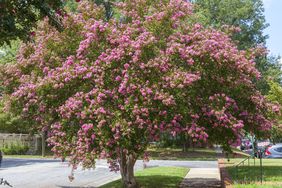
How To Grow And Care For Crepe Myrtle
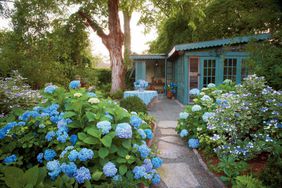
20 Dreamy Hydrangea Gardens That Are Giving Us Major Inspiration

What’s Wrong With My Crepe Myrtle? 5 Common Problems
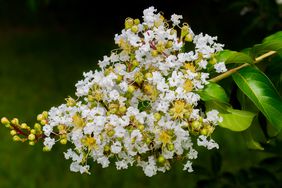
12 Large And Medium Crepe Myrtle Trees For Big Impact

How To Solve Common Crepe Myrtle Problems From Diseases To Pests

How To Grow A Crepe Myrtle From Cuttings Or Seed
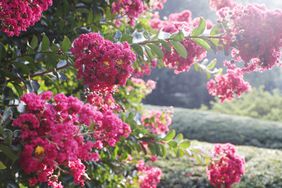
How To Prune A Crepe Myrtle Correctly
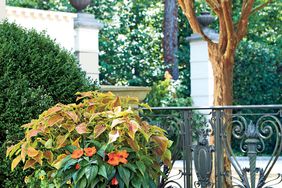
Our Best Container Gardening Ideas
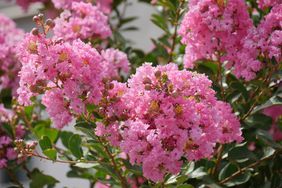
10 Tips For Growing Crepe Myrtles In Containers
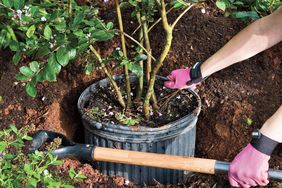
How To Plant A Crepe Myrtle

Crepe Murder Is The South’s Worst Gardening Crime

10 Best Trees To Plant For Fall Color
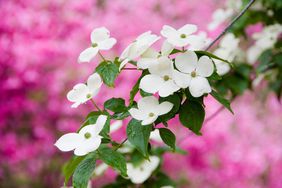
The South’s Most Iconic Plants
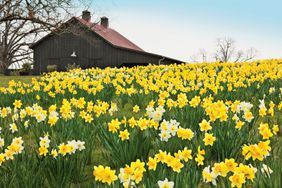
The South’s Most Iconic Flowers
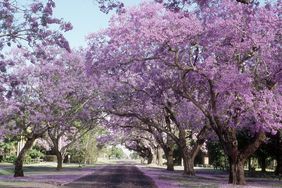
12 Flowering Southern Trees You Need To Plant Now
Newsletter Sign Up
Newsletter Sign Up
When you visit the site, Dotdash Meredith and its partners may store or retrieve information on your browser, mostly in the form of cookies. Cookies collect information about your preferences and your devices and are used to make the site work as you expect it to, to understand how you interact with the site, and to show advertisements that are targeted to your interests. You can find out more about our use, change your default settings, and withdraw your consent at any time with effect for the future by visiting Cookies Settings, which can also be found in the footer of the site.